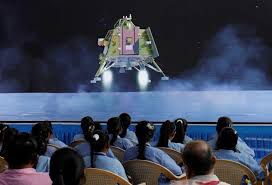
ndia’s space program has achieved a historic milestone with the successful landing of its Chandrayaan-3 mission on the Moon. This achievement marks a significant step forward for India’s ambitions in space exploration and cements the country’s position as a major player in the global space race.
Background of Chandrayaan-3 Mission
The Chandrayaan-3 mission is the third in India’s series of lunar exploration missions, following the Chandrayaan-1 mission in 2008 and Chandrayaan-2 in 2019. While Chandrayaan-1 made India the first country to discover water on the Moon, Chandrayaan-2’s mission to land on the Moon was only partially successful, with the orbiter functioning but the lander losing contact with Earth just before touchdown.
Learning from the challenges of Chandrayaan-2, the Indian Space Research Organisation (ISRO) set out to accomplish a successful landing on the lunar surface with Chandrayaan-3. The mission was designed to demonstrate India’s ability to land and operate on the Moon, focusing on a soft landing near the lunar south pole—a region of great scientific interest due to the presence of water ice.
The Success of Chandrayaan-3
On August 23, 2024, Chandrayaan-3 made a successful landing on the Moon, marking a historic achievement for India. The lander, named Vikram after the father of India’s space program, Vikram Sarabhai, touched down in a pre-selected region near the lunar south pole. The landing was a moment of immense pride for India, as it became the fourth country in history to successfully land a spacecraft on the Moon, following the United States, the Soviet Union, and China.
The success of Chandrayaan-3 was celebrated across India, with the nation’s leaders and citizens hailing it as a testament to the country’s growing technological capabilities. Prime Minister Narendra Modi congratulated ISRO scientists and engineers, describing the mission as a “giant leap for India’s space program” and a “moment of glory for every Indian.”
Scientific Goals and Discoveries
The primary goal of the Chandrayaan-3 mission is to explore the lunar south pole region, which is of great interest to scientists due to its unique environment. The presence of water ice in permanently shadowed craters offers valuable insights into the Moon’s history and the possibility of future human exploration.
The Vikram lander is equipped with a suite of scientific instruments designed to study the lunar surface, measure seismic activity, and analyze the composition of the soil. The data collected by these instruments will help scientists better understand the Moon’s geology and the potential resources available on its surface.
One of the key objectives of Chandrayaan-3 is to search for water ice in the shadowed craters near the lunar south pole. The presence of water on the Moon is crucial for future space exploration, as it could be used to produce oxygen, drinking water, and even rocket fuel. The findings from Chandrayaan-3 could pave the way for future missions to establish a sustainable human presence on the Moon.
India’s Growing Ambitions in Space
The success of Chandrayaan-3 is a significant milestone in India’s broader ambitions in space exploration. Over the past few decades, India has rapidly advanced its space program, launching a series of successful missions to explore the Moon, Mars, and beyond. The country’s achievements in space have positioned it as a major player in the global space race, alongside traditional space powers like the United States, Russia, and China.
India’s space program is not limited to lunar exploration. The country is also planning future missions to Mars, including a follow-up to its successful Mars Orbiter Mission (Mangalyaan), as well as missions to study the Sun, Venus, and asteroids. Additionally, India is working on developing its own crewed space mission, Gaganyaan, which aims to send Indian astronauts into space by 2025.
India’s space ambitions are driven by a combination of scientific curiosity, national pride, and strategic interests. The country views its space program as a way to enhance its technological capabilities, foster international collaboration, and assert its position as a leader in space exploration.
Global Impact and Collaboration
The success of Chandrayaan-3 has garnered international attention and praise, with many countries recognizing India’s achievements in space. The mission has also opened up opportunities for international collaboration, with India’s space program becoming an increasingly important partner in global space exploration efforts.
India has a history of collaboration with other space agencies, including NASA, the European Space Agency (ESA), and the Russian space agency Roscosmos. The success of Chandrayaan-3 is likely to strengthen these partnerships and lead to new opportunities for joint missions and research.
Furthermore, India’s space program has the potential to inspire other developing countries to invest in space exploration. India’s success demonstrates that even with limited resources, it is possible to achieve significant milestones in space. This could encourage other nations to pursue their own space ambitions, contributing to the global advancement of space science and technology.
Conclusion
The successful landing of Chandrayaan-3 on the Moon is a momentous achievement for India and a testament to the country’s growing capabilities in space exploration. As India continues to pursue its ambitious space goals, the world will be watching closely to see what new discoveries and milestones the country will achieve. Chandrayaan-3’s success not only cements India’s position as a major player in the global space race but also serves as an inspiration to future generations of scientists, engineers, and explorers.

































